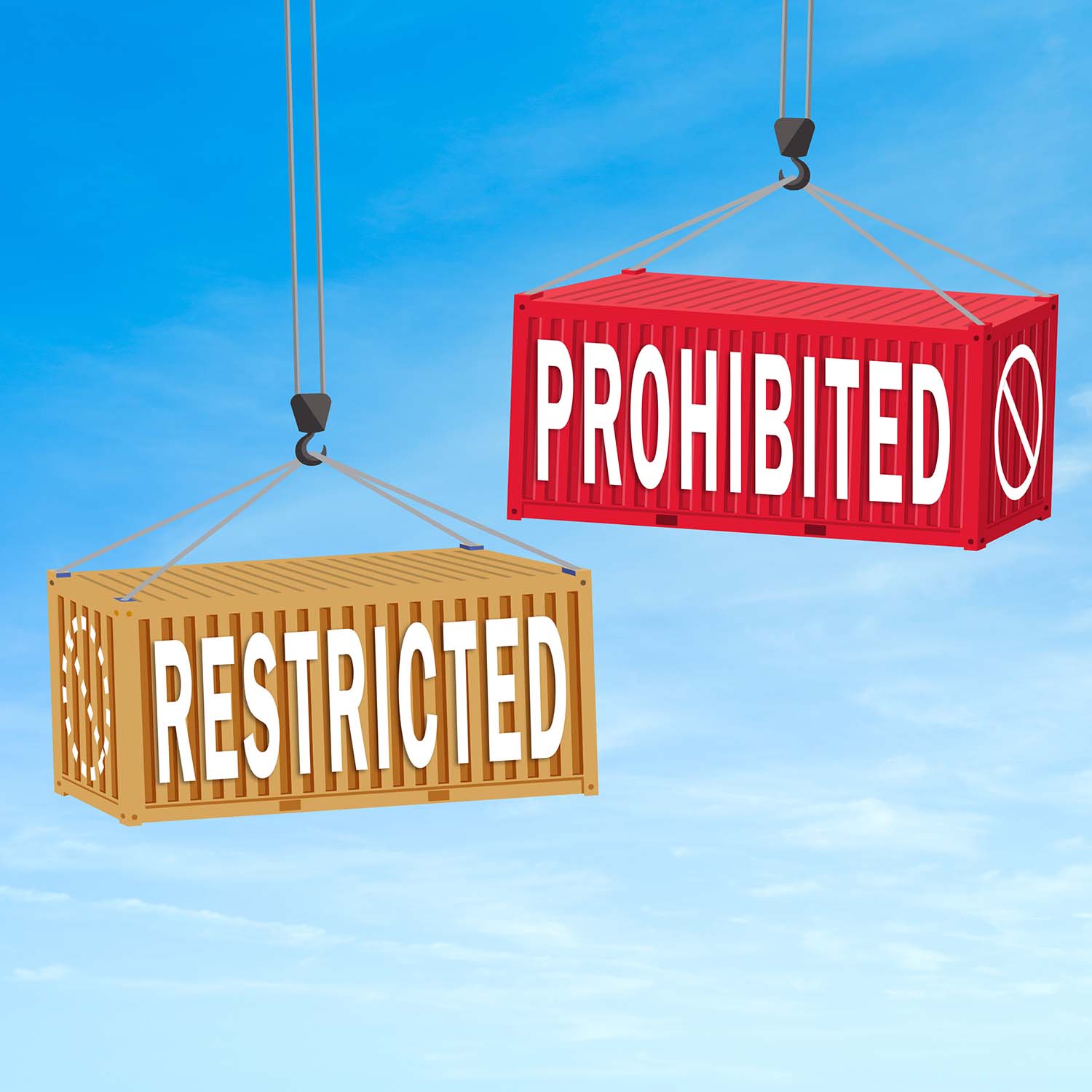Restrictions and Prohibitions
All countries restrict or prohibit the import and export of certain articles based upon:
- Concerns for health, safety, and public morality (e.g., foodstuffs, agricultural products, live animals, biologic materials, pharmaceuticals, illicit drugs, chemicals, hazardous products, and materials deemed indecent).
- Protection of the physical and economic security of the state (e.g., arms, armaments, dual-use technology, radio and television transmitters and receivers, radioactive materials, seditious materials, and currency).
- Economic protection or subsidization of domestic industry (e.g., non-tariff barriers to trade for imports and control of natural resources for exports).
- Enforcement of provisions of multi-lateral trade agreements (e.g., those designed to protect endangered and threatened species of animals and plants and those designed to protect copyright, patent, and trademark holders against infringement).
By Destination Country
In some cases, the degree of restriction depends on the destination country. This is true for dual-use goods, whether they are of civilian or military origin. Country-specific embargoes or moratoria may also be in effect and may be seasonal or of short duration.
By Quota
The export of certain goods is sometimes restricted by quotas, meaning the goods can be imported within the limits strictly set by the EU. An export license is required to export products subject to quotas. Examples of these products are industrial, agricultural, textile, and steel products.
Online Customs Tariff Database (Tarif Intégré de la Communauté or TARIC)
The EU's online tariff database known as the TARIC provides up-to-date information on restrictions and prohibitions based on a product's tariff classification code and country of origin or destination. Economic operators should always consult the TARIC for the most up-to-date information, as import restrictions and prohibitions are subject to frequent change. The TARIC can be accessed at www.ec.europa.eu/taxation_customs/dds2/taric.
Restricted Articles
Examples of products restricted from export from the EU and Estonia are:
Agricultural Products, Plants, and Foodstuffs
- Some agricultural products require an export license. The products concerned are determined by the EU's Common Agricultural Policy and currently include cereals, rice, beef and veal, sugar, isoglucose, oils and fats, and milk and milk products.
- Foodstuffs must comply with EU Food Law, in addition to any requirements set forth by the country of destination. Fresh fruit and vegetables must comply with EU marketing standards, and export of these products may requite a certificate of conformity to those standards.
- All goods subject to phytosanitary controls (plants and vegetable products, including fresh fruit and vegetables)
- Tobacco products and alcohol
Live Animals and Food of Animal Origin
- Live animals (cattle, swine, equidae, live poultry, hatching eggs, sheep and goats), semen, and embryos require an export license.
- Food of animal origin must comply with EU Food Law, in addition to any requirements set forth by the country of destination.
- Wild plants and animals threatened with extinction, or products made from those plants or animals, are regulated under the Convention on International Trade in Endangered Species of Wild Fauna and Flora (CITES), and licenses are issued by the Estonian CITES Management Authority.
Cultural Goods
- Archaeological objects and cultural goods and documents and paintings
- Goods with cultural values (export licenses are issued by member states competent authorities; in Estonia, the National Heritage Board)
Pharmaceuticals and Medical Products
- Controlled narcotic drugs, psychotropic substances, and drug precursors, pharmaceutical products, and veterinary medicines
Dangerous Goods
- Dangerous chemicals, regulated by the EU Registration, Evaluation, Authorization and Restriction of Chemicals (REACH)
- Pesticides
- Ozone-depleting substances
- Waste products
- Weapons, firearms and ammunition, explosives, dual-use goods (see below), military and paramilitary goods
- Radioactive substances and nuclear devices
Armaments and Dual-Use Goods
Some export restrictions and prohibitions enforce international treaties and agreements for peace and security. As a member of the EU, Estonia complies with EU regulations controlling exports of armaments and for dual-use goods, that is, civilian goods which have a potential application for military use or the development of weapons.
Dual-use articles and technologies require specific authorization depending on the country of destination of the goods:
- Community General Export Authorization applies to goods for shipment to Australia, Canada, Japan, New Zealand, Norway, Switzerland, and the United States of America
- Global National Export Authorization for repeated exports to some countries
- Individual Export Authorization for nonrecurring export orders
Prohibited Articles
Some articles are totally prohibited from being exported from the EU. Examples of these include:
- Counterfeit goods or pirated goods
- Offensive weapons (as defined by the EU)
- Products that could be used for the death penalty, torture, or other cruel, inhuman, or degrading treatment (subject to licensing by customs)
- Psychoactive substances
- Meat and bone meal
- Cat and dog fur, and products made from cat or dog fur
- Some products from Myanmar, the Republic of Guinea, Iran, North Korea, Côte d'Ivoire, Zimbabwe, Sudan, and Libya
- Arms embargoes apply to the following countries: Armenia, Azerbaijan, Bosnia-Herzegovina, China, Democratic Republic of Congo, Iraq, Côte d'Ivoire, Lebanon, Liberia, Myanmar, North Korea, Rwanda, Sierra Leone, Somalia, Sudan, and Zimbabwe
Special Registration Requirements
Trade Control and Expert System (TRACES)
The European Commission's Trade Control and Expert System (TRACES) is an online platform for sanitary and phytosanitary certification required for the import of animals, animal products, food and feed of non-animal origin, and plants into the EU as well as intra-EU trade and EU exports of animals and certain animal products. The main objective of TRACES is to streamline the certification process and all linked entry procedures and to offer a fully digitized and paperless workflow.
Note: Export restrictions and prohibitions are subject to change. It is important to obtain the latest information from a customs broker, freight forwarder, the local customs authorities, or TARIC database at www.ec.europa.eu/taxation_customs/dds2/taric/taric_consultation.jsp.
Sources: European Commission (www.ec.europa.eu); Estonian Tax and Customs Board (Maksu ja Tolliamet) (www.emta.ee)
Article written for World Trade Press by Brielle Burt, Jennifer Goheen, and Nina Bellucci.
Copyright © 1993-2025 World Trade Press. All rights reserved.



